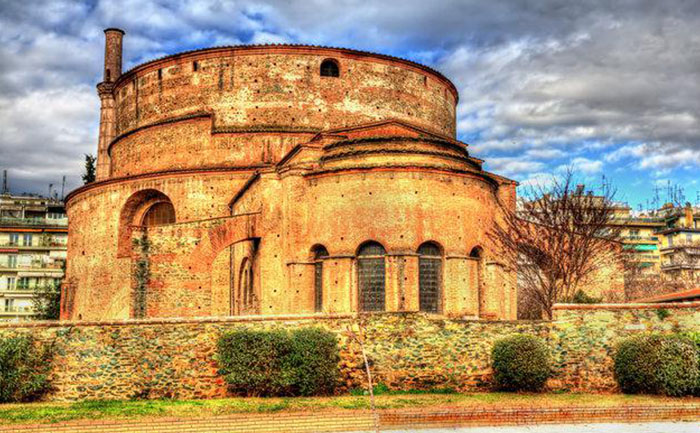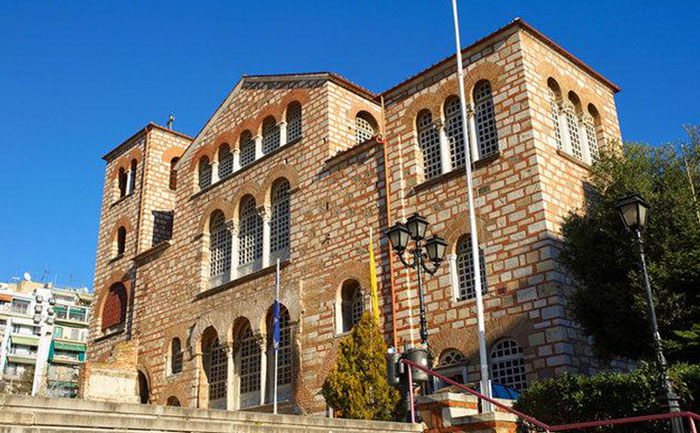Must see in Thessaloniki
Must see in Thessaloniki, Transfer to the center
Thessaloniki (also known as Salonica) offers the cosmopolitan culture and energy of a big city with the friendly ambience and charm of a smaller town. It's a wonderful destination to experience the real Greece. This delightful city has an impressive multiethnic heritage, influenced by the different civilizations that have left their mark, including the Romans, Venetians, and Ottoman Turks. Visitors are awed by the ancient ruins, Byzantine churches, and the world-class archaeology museum, one of the best in Greece. Another highlight is the delicious local cuisine; top-rated restaurants tantalize diners with the region's finest culinary fare. Thessaloniki is also famous for its music scene, and live band performances take place at venues throughout the city at almost any time of the year. 1. Roman Rotunda (Saint George's Church) The Roman Rotunda is Thessaloniki's most magnificent ancient monument. Built in the early fourth century, it was most likely intended to be Emperor Galerius' mausoleum (although he was not buried here) and was part of the complex that included the Galerius Palace and the Arch of Galerius. Emperor Theodosius the Great, who was baptized as a Christian in Thessaloniki, converted the mausoleum into a Christian church in the late fourth century. During the 10th to 12th centuries, the Rotunda was used as the Cathedral of Thessaloniki. Under Ottoman rule, the building was converted to a mosque; the minaret is a relic of the Islamic era. After the liberation from the Turks in 1912, the Rotunda was transformed into the Church of Saint George (Áyios Yeóryios). This grandiose sanctuary makes a breathtaking impression. More than 24 meters in diameter and 30 meters in height, the Rotunda features cylindrical domed architecture similar to the Pantheon in Rome. Inside, gorgeous mosaics decorate the dome and the vaulted recesses. The mosaic in the center of the dome is missing, but below it are charming figures of angels and architectural facades on a gold background. The Rotunda houses a Sculpture Museum and is open to the public daily for visits. 2. The White Tower: Relic of the Byzantine-Era Ramparts The most recognizable landmark of Thessaloniki, the White Tower can be reached by taking a scenic walk along the Seafront Promenade. In a small public garden at the southern end of the promenade, the White Tower (Lefkós Pyrgos) was once part of the town's ancient ramparts. The circuit of fortification walls no longer remains completely intact; the White Tower is the only relic of the seaward defenses. Built by the Ottoman Turks around 1530, this imposing tower was used mainly as a prison. Today, tourists can visit the tower and ascend to the viewing platform on the top, which offers sensational views of the city and harbor. The White Tower also houses the permanent collection of the Museum of Byzantine Culture. The museum's exhibits educate visitors about Byzantine history and art in Thessaloniki from around AD 300 until its capture by the Turks in 1430. The collection includes a wide range of artifacts such as early Christian coins, vases, mosaics, wall paintings, and liturgical objects. The White Tower also hosts temporary exhibitions such as presentations of Byzantine religious paintings. 3. Church of Saint Demetrius A must-see spiritual sight in Thessaloniki, the Church of Saint Demetrius (Ayios Dimítrios) is the town's main church. During the Turkish period, it was converted into a mosque, the Kasimiye Cami. North of the Roman Agora, this splendid five-aisled Byzantine basilica was built in the fifth century on the site of an earlier Christian church near the ancient Roman bathhouse. (Remains of the bathhouse are visible on the north side of the church.) The crypt also contains relics of an ancient Roman road. The church was named after the town's Patron Saint, Demetrius, who was imprisoned and executed here in the year 306. For centuries, pilgrims have come from all over the Byzantine Empire to venerate the saint's relics, which are preserved in a sarcophagus in front of the iconostasis. Spiritual pilgrims and tourists alike are awe-inspired when entering the church's interior. The glorious sanctuary is 43 meters long, the largest in Greece, and is richly embellished. Adornments include finely carved capitals on the varicolored marble columns, a dazzling chandelier in the central aisle, and small mosaics on the pillars in the apse. 4. Arch of Galerius Walking from Egnatia Street towards Thessaloniki's city center, visitors will come across the Arch of Galerius (Apsída Galeríou), an ancient Roman monument dating to around AD 297. This arch was the ancient town's main entrance gate. Of the original structure, three piers of the west side remain. Two of the surviving piers, linked by an arch, feature a marble facade decorated with elaborate reliefs. The reliefs, separated by garlands, depict battle scenes from Emperor Galerius' Persian, Mesopotamian, and Armenian campaigns of the third and fourth centuries. These ornately carved reliefs are among the finest of their kind. Be sure to notice the animated scenes on the south pier. Although badly weathered, the reliefs are much better preserved than contemporary reliefs on the Arch of Constantine in Rome, dating to AD 315. 5. Archaeology Museum This renowned museum presents a superb collection of artifacts that were uncovered in Thessaloniki as well as all over ancient Macedonia. The collection spans from prehistory to late antiquity. Be sure to see the sculptures from the Archaic to Late Roman era. Several rooms display architectural elements from an Ionic temple of the sixth century BC. Other exhibits show excavation findings from a Neolithic settlement at Makriyalo in Pieria, artifacts from the ancient palace built by Emperor Galerius, and the reconstruction of a Macedonian tomb in Ayia Paraskevi. The archaeological museum also hosts temporary exhibitions on various themes such as the Coins of Macedonia. A showcase in the lobby of the museum displays finds from a Neolithic site, accompanied by information about the progress of the excavation. Address: 6 Manolis Andronikos Street, Hanth Square, Thessaloniki 6. Ano Poli (Upper Town) The Ano Poli is the historic old town, known as the Upper Town because of its hilltop location. The upper town can be reached from Odós Olympíados, the curving street that links the lower town on the north to the old town walls and citadel. This atmospheric quarter is characterized by its steep, winding streets and pedestrian alleyways. Numerous fountains of the Ottoman era reveal the quarter's Turkish influence. The Ano Poli has many noteworthy historic churches, including Saint Catherine's Church, the Church of the Prophet Elijah, the Church of the Taxiarchs (Archangels), the Church of the Holy Apostles, and the must-see Church of Ósios Davíd that was built in the fifth and sixth centuries and is renowned for its splendid mosaic depicting the prophet Ezekiel's vision. Another famous site in this area is the Turkish Consulate on Odós Apóstolou Pávlou, which is the house where Mustafa Kemal Pasha (Atatürk), first President of the Turkish Republic, was born in 1881. Premium Taxi Halkidiki is happy to arrange transfers for your family to the center of Thessaloniki, agree on meetings for the return trip. We remind you that the Premium Taxi waiting at the city for free.
Roman Rotunda (Saint George's Church)
The White Tower
Church of Saint Demetrius
Arch of Galerius
Archaeology Museum
Ano Poli (Upper Town)








